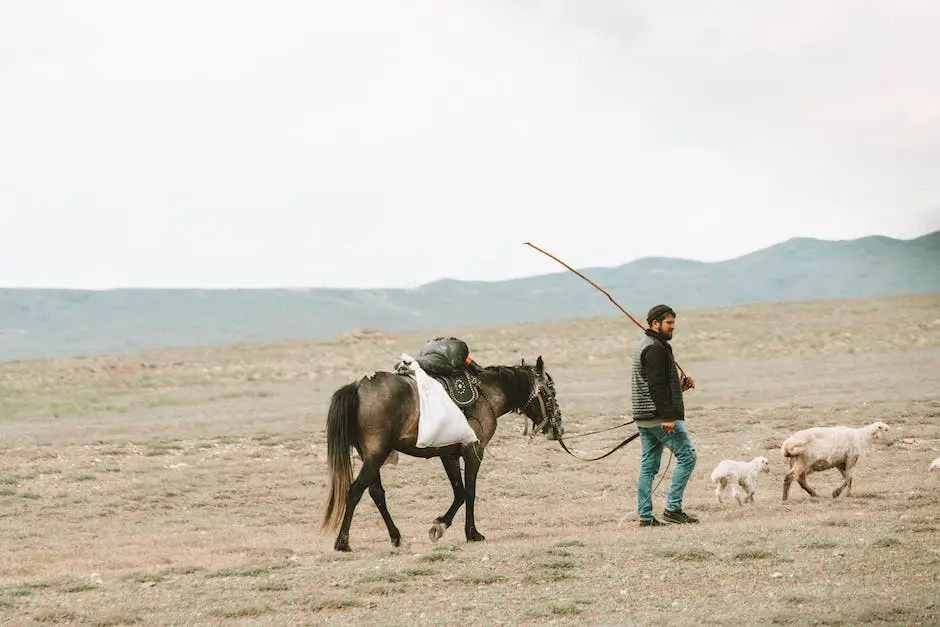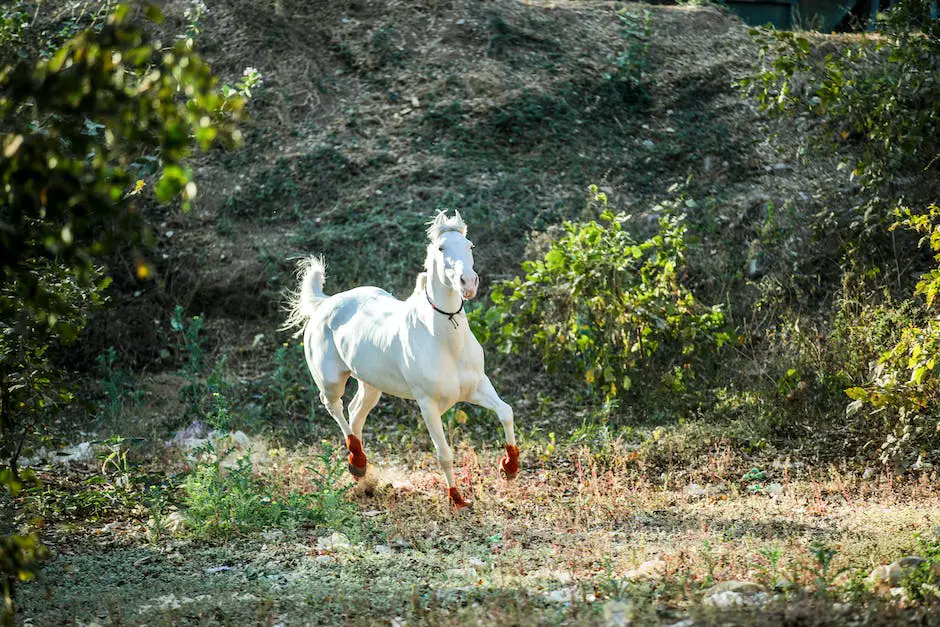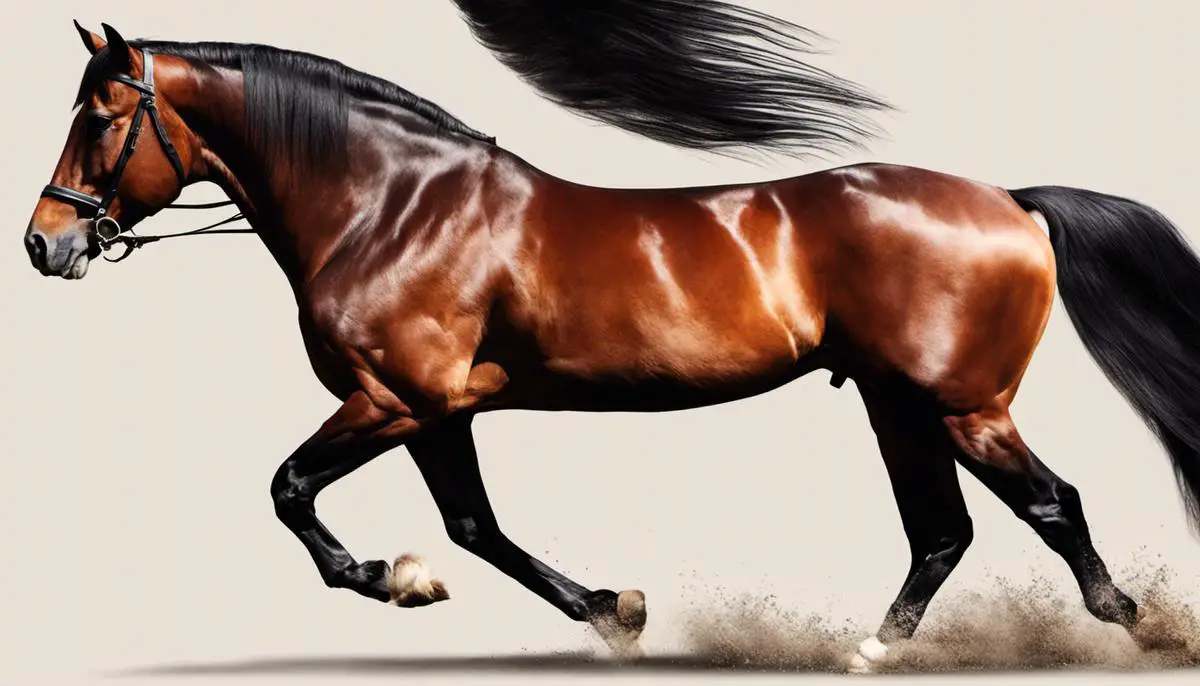Delve into the captivating world of the Rhenish German Coldblood, a robust and versatile draft horse breed that hails from the heartlands of Germany. This essay unfolds the intriguing journey of these equine giants from their early origins to their contemporary relevance across various sectors. Immerse yourself in the historical context of its breeding, the founding stallions that forged its lineage and the transformation it underwent over the years. The intrinsic physical attributes, temperament, lifespan, health profile, and any unique attributes that set this breed apart, are carefully examined, with supporting visuals to enhance your understanding. Further, the narrative takes a turn towards the pragmatic functionalities fulfilled by the Coldbloods, whether in agriculture, sports, or manual labor, evaluating both their strengths and potential limitations. Finally, the focus shifts towards their conservation status and efforts deployed to ensure their continued existence.
Table of Contents (Horspedia)
Origin and History of the Rhenish German Coldblood
Origins of the Rhenish German Coldblood
The Rhenish German Coldblood breed, known in Germany as the Rheinisches Deutsches Kaltblut, has its origins in the Rhineland region of Germany. The development of the breed dates back to the late 19th century and it is considered one of the youngest German draught horse breeds.
Founding Stallions of Rhenish German Coldblood
The breeding history of the Rhenish German Coldblood is significantly connected to two founding stallions, which were marked by their size, strength, and work capacity. The first is the “Vos I,” a light draught horse imported from the Netherlands. Vos I was used as a breeding stallion from 1873 to 1888 in Clydesdale and Belgium. The second founding stallion, “Alderfuchs,” was used in breeding from 1883 until 1899. Alderfuchs was a strong, heavy draught horse with excellent body dimensions and health conditions.
Historical Context of Rhenish German Coldblood
The Rhenish German Coldblood was bred to perform heavy labor in agriculture and industry, especially at a time when horses were the primary source of power for these tasks. Their breeding was heavily influenced by the industrial expansion in the Rhineland area during the late 19th and early 20th centuries. The demand for draught horses was high, as they were needed for agricultural tasks, pulling heavy loads in industrial settings, and for transportation.
Significant Evolution Over the Years
Throughout the years, the breeding of the Rhenish German Coldblood has gone through a significant evolution, responding to changes in demand and the context of the times. During the 20th century, lighter horses were favored, while after World War II, heavier types were once again sought-after. This alternating focus has influenced the overall breed characteristics.
Present Day Importance
Today, the Rhenish German Coldblood is often used for meat production due to the decline in the need for working horses. However, various initiatives have been put in place to preserve the breed as a cultural and biological heritage. For instance, the breed is often seen at traditional horse shows, serving as a reminder of its historical importance.
The history of the Rhenish German Coldblood horse breed is a testament to the societal changes over time, including varying industrial and agricultural needs, evolving demands for equine abilities, and shifting views about the role of horses. Despite a decline in its population, the breed remains a cherished part of Rhineland history and heritage, and is acknowledged for its significant historical and cultural contributions.

Photo by alpacccca on Unsplash
Characteristics and Traits of the Rhenish German Coldblood
An Overview of the Rhenish German Coldblood’s Physical Attributes
The Rhenish German Coldblood is a draft horse breed admired for its impressive size and might. Typically, horses of this breed have a height ranging from 15.2 to 16.2 hands (or approximately 62 to 66 inches) at the shoulder and are noted for their broad, muscular physique. Despite their size, these horses are evenly proportioned and feature a wide forehead, small expressive eyes, a straight muzzle, and stout legs with substantial joints and wide hooves. They are further distinguished by their thick mane and tail, and their coat may come in varied colors, including black, brown, bay, and roan.
Temperamental Traits
The Rhenish German Coldblood breed is known for its calm and docile temperament. These horses are patient, reliable, and have a natural inclination to work, making them suitable for a variety of tasks, including farming, logging, and hauling. Their gentle nature also makes them ideal for interactions with humans, including children.
Lifespan and Health
The lifespan of a Rhenish German Coldblood horse tends to average around 25-30 years, which is somewhat standard for horse breeds of this size. They are known for being a healthy and hardy breed, often thriving in environments that other horse breeds may struggle in. However, like all large breeds, they can be prone to certain health issues, including lameness and osteoarthritis due to their size and weight. Regular vet check-ups, along with balanced nutrition and exercise, can help maintain good health in these horses.
Unique Characteristics
Rhenish German Coldblood horses are unique for several reasons. First, they’re distinguished by their sheer strength and physical prowess. Despite their sheer size, these horses are known for their agility and endurance. Second, they have a genetic diversity that is quite high, particularly compared to other coldblood breeds. This is due to careful breeding practices that emphasized the preservation of the breed’s health and vitality over time.
Despite the breed’s strengths and unique assets, the population nearly died out in the 1970s due to a lesser demand for working horses. The breed was revived with the help of the government and breed enthusiasts, who recognized the need to preserve the unique genetic heritage and historical significance of the Rhenish German Coldblood.
Modern Day Roles
Modern-day roles for the Rhenish German Coldblood vary widely, from agricultural work to leisure riding, and even therapy work, thanks to their calm temperaments. In agricultural settings, they are used for pulling heavy machinery or transporting heavy goods. Their strength and endurance make them excellent workhorses on small farms. In leisure settings, their calm and patient nature makes them ideal for beginner riders or those looking to build confidence on horseback. Their gentle nature and strength also make them suitable for equine-assisted therapy programs.
Understanding the Rhenish German Coldblood Horse
The Rhenish German Coldblood, a breed noted for its strength, endurance, and calm demeanor, is deeply woven into the cultural fabric of its origin region. More than just a robust work horse, it stands as a resilient piece of living heritage, conveying the spirit and history of the place it came from. The physical attributes of these horses – sturdy and powerful, yet peaceful – set them apart and make them a truly unique breed.

Rhenish German Coldblood’s Role in Agriculture, Sport, and Work
A Closer Look at the Rhenish German Coldblood
The Rhenish German Coldblood, also known as “Rheinisches Kaltblut,” is a draft horse breed primarily found in Germany’s Rhineland region. Having gained significant importance during the industrial revolution for its impressive strength, speed and stamina, this horse breed has played a crucial role in propelling Germany’s agricultural, sports, and labor industries forward. The powerful Rheinisches Kaltblut truly underscores the breed’s historical and ongoing relevance to the region and country at large.
In Agriculture
Rhenish German Coldblood horses have played a significant role in agriculture, particularly before the advent of mechanized farming. Their power and stamina have made them the preferred choice for heavy plowing, pulling carts, and performing other farm tasks. Because these horses are strong and capable of pulling heavy loads, they were and still are invaluable assets on farms. Their docile nature and cooperative demeanor also make them easy to handle, thus simplifying their use in agricultural operations.
In Sport
Over time, people began to recognize the Rhenish German Coldblood’s aptitude for sports, particularly for driving and pulling contests. Their innate strength, combined with their trainability, made them suitable for heavy horse competitions, where their impressive capabilities could be displayed. Although they might not have the speed and flexibility of lighter breeds, they draw attention due to their sheer power and determination. Despite their large size, they are known for their surprising agility.
In Work
Beyond agricultural and sports contexts, Rhenish German Coldblood horses are also used for work, notably for logging in forestry. Their size and strength come in handy in rough terrains where machines cannot venture. In urban areas, they are frequently used for pulling carriages, particularly in commercial and touristic settings, due to their endurance and gentle nature. Their calm temperament makes them suitable for jobs that involve close interaction with people.
Strengths and Limitations
The Rhenish German Coldblood’s main strengths lie in their physical abilities and temperament. Their powerful stature fits perfectly with tasks requiring strength, and their placid and congenial nature makes them easy to work with. However, they may not be as suitable for tasks requiring speed and nimbleness. As a coldblood breed, they are built for power rather than speed.
Care for these horses can involve significant commitment due to their large size and dietary needs. They need plenty of high-quality fodder to maintain their strength but might be susceptible to obesity and related health issues if they are overfed or not exercised adequately. Additionally, like all draft breeds, they are at a higher risk for certain genetic disorders. Regular screenings and prompt veterinary intervention can help manage these risks.
The Rhenish German Coldblood, a resilient and versatile breed, plays a critical role in various sectors such as agriculture, sports, and work. Despite challenges, they remain an emblematic representation of the historical and current significance of draft horses in human society.

Conservation Status and Efforts for the Rhenish German Coldblood
Endangered Status of the Rhenish German Coldblood
According to the Federal Conservation Office of Germany, the Rhenish German Coldblood is categorized as an endangered species due to a notable decline in its population. This precarious situation is further highlighted by the European Association for the Conservation of Grazeable Horse Breeds, which has marked this breed on its ‘Red List.’
The population decrease is especially evident in the breeding pool. In 2018, only 390 female breeding animals were reported. This alarming reduction is mainly a result of farms transitioning from the use of draft horses to more technologically advanced machinery.
Challenges and Risks
The decline of the Rhenish German Coldblood population is attributed not only to the increased use of machinery in farming but also the rise in cross-breeding. Pure breeding has become less frequent with a surge in preferences for lighter, faster horses. This has made it a lot harder to maintain the breed, thereby posing a serious risk to its survival.
Further, horses of this breed face health problems like degenerative suspensor ligament desmitis, a condition that affects a horse’s movement ability, making it less useful for common draft work or other tasks historically assigned to this breed.
Governmental Efforts and Conservation Measures
The German government recognises the critical status of the Rhenish German Coldblood, and initiatives at both federal and state levels are underway. These measures include financial incentives for breeders to encourage the breeding and maintenance of purebreeds.
The Rhineland Studbook of North Rhine-Westphalia oversees the breeding programs for Rhenish German Coldblood horses. It exercises rigid inspection and certification processes to ensure the propagation of high-quality, purebred Rhenish German Coldblood horses.
Private Sector Initiatives
In contrast, private associations like the Society for the Conservation of Old and Endangered Livestock Breeds and the European Association for the Conservation of Grazeable Horse Breeds play a vital role. They conduct valuable work in raising awareness, providing information and resources to breeders, and lobbying for legislative protection and support.
Furthermore, various breeders’ associations organize horse shows and competitions to promote the breed. Efforts are undertaken to showcase exceptional horses and celebrate the breed’s strengths, thereby encouraging more people to adopt and care for these animals.
All in all, the future of the Rhenish German Coldblood breed depends on combined public and private initiatives to increase its population. By maintaining rigorous breeding standards and providing effective incentives, it’s hoped that this distinctive horse breed will not just survive but flourish once more in the future.

Having traversed through the multifaceted existence of the Rhenish German Coldblood, one is left with an appreciation for this steadfast breed and the crucial roles they render in various facets of life. Their sheer physical might, coupled with a gentle disposition, makes them an invaluable asset to many sectors, including agriculture and sports. However, the question of their sustainability looms large, making conservation initiatives crucial to their survival. Thus, there is an inherent responsibility that lies on the shoulder of society, both public and private sectors, to participate actively in conserving this magnificent breed. The continued existence of the Rhenish German Coldblood is not just about preserving a breed, but also about maintaining an integral fragment of our cultural and agricultural history.

